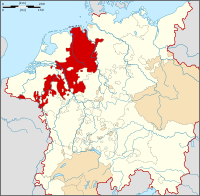- County of Manderscheid
-
County of Manderscheid
Grafschaft ManderscheidState of the Holy Roman Empire ← 
10th century – 1488 
Coat of arms
County of Manderscheid on a map from 1696 Capital Manderscheid Government Principality Historical era Middle Ages - Established 10th century - Partitioned into three 1488 County of Sternberg-Manderscheid
Grafschaft Sternberg-Manderscheid (de)State of the Holy Roman Empire ← 
1780–1794  →
→Capital Oberkail Government Principality Historical era Middle Ages - Acquired Manderscheid
by jure uxoris
1780 1780- Annexed by France 1794 - Mediatised to
Württemberg
1806The Manderscheid family was the most powerful family in the Eifel region of Germany for a considerable period of time in the 15th century. In 1457, Dietrich III von Manderscheid was made a Reichsgraf (Imperial count) by the Emperor (probably Frederick III). When Dietrich died on February 20, 1498, he had appointed his sons Johann, Konrad and Wilhelm as new rulers — the family property had been distributed in 1488. Each of the sons founded a powerful lineage: Johann started the Manderscheid-Blankenheim-Gerolstein line, William the Manderscheid-Kail line, and Konrad (Cuno) the Manderscheid-Schleiden line. Augusta von Manderscheid-Blankenheim was the last countess. She was married to a member of the Bohemian nobility, the count of Sternberg.
The Manderscheid-Kail lineage
The ancestral seat was the former moated castle in Oberkail, and because of this, Oberkail gained and maintained considerable importance in the Eifel region for several centuries. The moated palace is no longer standing — the last count of Oberkail died without descendants in 1762, the moated castle was destroyed and Oberkail returned to the status of a non-notable Eifel village.
Witch-hunts and French takeover
Eifel was underdeveloped and troubled by plagues, witch-hunts and feuds in the 17th century. Within the area of the Manderscheider counties, approximately 260 people were executed as witches between 1528 and 1641. In other regions of Germany, reformation and technical inventions had led to great progress. In 1794, French revolutionary troops took control of the Rhine country and the Eifel region without great bloodshed and eliminated the aristocracy and the feudal system. Taxes such as socage duty, tithes and local customs duties were abolished. French became the official language, the judiciary system was updated and the economy in Eifel experienced a boost.
Archives
The originals of certificates and documents (such as deeds of ownership and commercial documents) that the family had taken with them on their flight to Bohemia are stored in the National Museum (Prague). After these documents were copied onto microfilm in the 1970s, a copy was stored in an archive in Brauweiler near Cologne. The documents are still awaiting a scientific evaluation.
-
Lower castle of Manderscheid, with the ruin of the upper castle in the background
 Lower Rhenish–Westphalian Circle (1500–1806) of the Holy Roman Empire
Lower Rhenish–Westphalian Circle (1500–1806) of the Holy Roman EmpireEcclesiastical Prelates Secular Counts
and lordsfrom 1500Bentheim · Bronkhorst (until 1719) · Diepholz · East Frisia (until 1667) · Horne3 (until 1614) · Hoya · Lingen3 · Lippe · Manderscheid (until 1546) · Moers (until 1541) · Nassau (Diez · Hadamar · Dillenburg (until 1664)) · Oldenburg (until 1777) · Pyrmont · Ravensberg3 · Reichenstein · Rietberg · Salm-Reifferscheid · Sayn · Schaumburg · Tecklenburg · Virneburg · Wied · Winneburg and Beilstein · Zimerauff?from 1792Anholt · Blankenheim and Gerolstein · Gemen · Gimborn · Gronsfeld · Hallermund · Holzapfel · Kerpen-Lommersum · Myllendonk · Reckheim · Schleiden · Wickrath · Wittemstatus
uncertainCities 1 from 1792. 2 until 1792. 3 without Reichstag seat. ? status uncertain.Categories:- Former principalities
- Former polities in the Netherlands
- States of the Holy Roman Empire
- States and territories established in the 10th century
- States and territories disestablished in 1488
- States and territories established in 1780
- States and territories disestablished in 1794
- 1488 disestablishments
- German nobility
- States and territories established in the 18th century
- Lower Rhenish-Westphalian Circle
- History of the Rhineland
Wikimedia Foundation. 2010.
Look at other dictionaries:
Manderscheid, Bernkastel-Wittlich — Manderscheid … Wikipedia
Manderscheid — can refer to: Manderscheid, Bernkastel Wittlich, a town in the district Bernkastel Wittlich, Rhineland Palatinate, Germany. Manderscheid, Bitburg Prüm a village in the district Bitburg Prüm, Rhineland Palatinate, Germany, part of the… … Wikipedia
County of Bentheim — Grafschaft Bentheim (de) State of the Holy Roman Empire ← … Wikipedia
County of Mark — Grafschaft Mark (de) State of the Holy Roman Empire ← … Wikipedia
County of Virneburg — Coat of arms … Wikipedia
County of Ravensberg — For the city in Baden Württemberg, see Ravensburg. County of Ravensberg Grafschaft Ravensberg State of the Holy Roman Empire (until 1806) … Wikipedia
County of Hoya — Grafschaft Hoya redirects here. For the present administrative unit, see Grafschaft Hoya (Samtgemeinde). County of Hoya Grafschaft Hoya (de) State of the Holy Roman Empire … Wikipedia
County of Beilstein — Lordship of Winneburg and Beilstein Herrschaft Winneburg und Beilstein State of the Holy Roman Empire ← … Wikipedia
Ormont — Ormont … Wikipedia
Duppach — Duppach … Wikipedia
-



